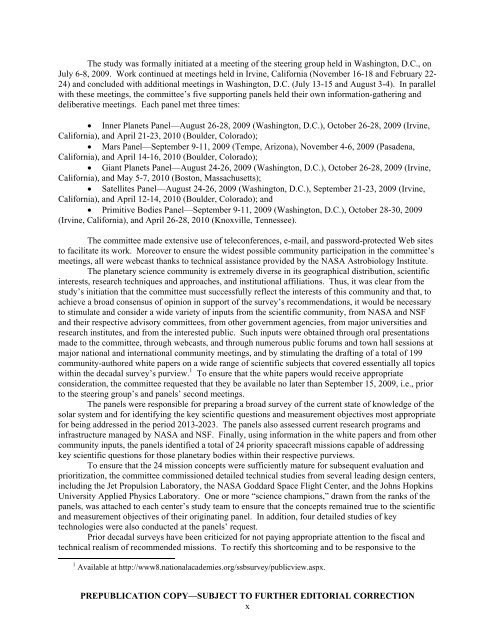Vision and Voyages for Planetary Science in the - Solar System ...
Vision and Voyages for Planetary Science in the - Solar System ...
Vision and Voyages for Planetary Science in the - Solar System ...
Create successful ePaper yourself
Turn your PDF publications into a flip-book with our unique Google optimized e-Paper software.
The study was <strong>for</strong>mally <strong>in</strong>itiated at a meet<strong>in</strong>g of <strong>the</strong> steer<strong>in</strong>g group held <strong>in</strong> Wash<strong>in</strong>gton, D.C., on<br />
July 6-8, 2009. Work cont<strong>in</strong>ued at meet<strong>in</strong>gs held <strong>in</strong> Irv<strong>in</strong>e, Cali<strong>for</strong>nia (November 16-18 <strong>and</strong> February 22-<br />
24) <strong>and</strong> concluded with additional meet<strong>in</strong>gs <strong>in</strong> Wash<strong>in</strong>gton, D.C. (July 13-15 <strong>and</strong> August 3-4). In parallel<br />
with <strong>the</strong>se meet<strong>in</strong>gs, <strong>the</strong> committee’s five support<strong>in</strong>g panels held <strong>the</strong>ir own <strong>in</strong><strong>for</strong>mation-ga<strong>the</strong>r<strong>in</strong>g <strong>and</strong><br />
deliberative meet<strong>in</strong>gs. Each panel met three times:<br />
• Inner Planets Panel—August 26-28, 2009 (Wash<strong>in</strong>gton, D.C.), October 26-28, 2009 (Irv<strong>in</strong>e,<br />
Cali<strong>for</strong>nia), <strong>and</strong> April 21-23, 2010 (Boulder, Colorado);<br />
• Mars Panel—September 9-11, 2009 (Tempe, Arizona), November 4-6, 2009 (Pasadena,<br />
Cali<strong>for</strong>nia), <strong>and</strong> April 14-16, 2010 (Boulder, Colorado);<br />
• Giant Planets Panel—August 24-26, 2009 (Wash<strong>in</strong>gton, D.C.), October 26-28, 2009 (Irv<strong>in</strong>e,<br />
Cali<strong>for</strong>nia), <strong>and</strong> May 5-7, 2010 (Boston, Massachusetts);<br />
• Satellites Panel—August 24-26, 2009 (Wash<strong>in</strong>gton, D.C.), September 21-23, 2009 (Irv<strong>in</strong>e,<br />
Cali<strong>for</strong>nia), <strong>and</strong> April 12-14, 2010 (Boulder, Colorado); <strong>and</strong><br />
• Primitive Bodies Panel—September 9-11, 2009 (Wash<strong>in</strong>gton, D.C.), October 28-30, 2009<br />
(Irv<strong>in</strong>e, Cali<strong>for</strong>nia), <strong>and</strong> April 26-28, 2010 (Knoxville, Tennessee).<br />
The committee made extensive use of teleconferences, e-mail, <strong>and</strong> password-protected Web sites<br />
to facilitate its work. Moreover to ensure <strong>the</strong> widest possible community participation <strong>in</strong> <strong>the</strong> committee’s<br />
meet<strong>in</strong>gs, all were webcast thanks to technical assistance provided by <strong>the</strong> NASA Astrobiology Institute.<br />
The planetary science community is extremely diverse <strong>in</strong> its geographical distribution, scientific<br />
<strong>in</strong>terests, research techniques <strong>and</strong> approaches, <strong>and</strong> <strong>in</strong>stitutional affiliations. Thus, it was clear from <strong>the</strong><br />
study’s <strong>in</strong>itiation that <strong>the</strong> committee must successfully reflect <strong>the</strong> <strong>in</strong>terests of this community <strong>and</strong> that, to<br />
achieve a broad consensus of op<strong>in</strong>ion <strong>in</strong> support of <strong>the</strong> survey’s recommendations, it would be necessary<br />
to stimulate <strong>and</strong> consider a wide variety of <strong>in</strong>puts from <strong>the</strong> scientific community, from NASA <strong>and</strong> NSF<br />
<strong>and</strong> <strong>the</strong>ir respective advisory committees, from o<strong>the</strong>r government agencies, from major universities <strong>and</strong><br />
research <strong>in</strong>stitutes, <strong>and</strong> from <strong>the</strong> <strong>in</strong>terested public. Such <strong>in</strong>puts were obta<strong>in</strong>ed through oral presentations<br />
made to <strong>the</strong> committee, through webcasts, <strong>and</strong> through numerous public <strong>for</strong>ums <strong>and</strong> town hall sessions at<br />
major national <strong>and</strong> <strong>in</strong>ternational community meet<strong>in</strong>gs, <strong>and</strong> by stimulat<strong>in</strong>g <strong>the</strong> draft<strong>in</strong>g of a total of 199<br />
community-authored white papers on a wide range of scientific subjects that covered essentially all topics<br />
with<strong>in</strong> <strong>the</strong> decadal survey’s purview. 1 To ensure that <strong>the</strong> white papers would receive appropriate<br />
consideration, <strong>the</strong> committee requested that <strong>the</strong>y be available no later than September 15, 2009, i.e., prior<br />
to <strong>the</strong> steer<strong>in</strong>g group’s <strong>and</strong> panels’ second meet<strong>in</strong>gs.<br />
The panels were responsible <strong>for</strong> prepar<strong>in</strong>g a broad survey of <strong>the</strong> current state of knowledge of <strong>the</strong><br />
solar system <strong>and</strong> <strong>for</strong> identify<strong>in</strong>g <strong>the</strong> key scientific questions <strong>and</strong> measurement objectives most appropriate<br />
<strong>for</strong> be<strong>in</strong>g addressed <strong>in</strong> <strong>the</strong> period 2013-2023. The panels also assessed current research programs <strong>and</strong><br />
<strong>in</strong>frastructure managed by NASA <strong>and</strong> NSF. F<strong>in</strong>ally, us<strong>in</strong>g <strong>in</strong><strong>for</strong>mation <strong>in</strong> <strong>the</strong> white papers <strong>and</strong> from o<strong>the</strong>r<br />
community <strong>in</strong>puts, <strong>the</strong> panels identified a total of 24 priority spacecraft missions capable of address<strong>in</strong>g<br />
key scientific questions <strong>for</strong> those planetary bodies with<strong>in</strong> <strong>the</strong>ir respective purviews.<br />
To ensure that <strong>the</strong> 24 mission concepts were sufficiently mature <strong>for</strong> subsequent evaluation <strong>and</strong><br />
prioritization, <strong>the</strong> committee commissioned detailed technical studies from several lead<strong>in</strong>g design centers,<br />
<strong>in</strong>clud<strong>in</strong>g <strong>the</strong> Jet Propulsion Laboratory, <strong>the</strong> NASA Goddard Space Flight Center, <strong>and</strong> <strong>the</strong> Johns Hopk<strong>in</strong>s<br />
University Applied Physics Laboratory. One or more “science champions,” drawn from <strong>the</strong> ranks of <strong>the</strong><br />
panels, was attached to each center’s study team to ensure that <strong>the</strong> concepts rema<strong>in</strong>ed true to <strong>the</strong> scientific<br />
<strong>and</strong> measurement objectives of <strong>the</strong>ir orig<strong>in</strong>at<strong>in</strong>g panel. In addition, four detailed studies of key<br />
technologies were also conducted at <strong>the</strong> panels’ request.<br />
Prior decadal surveys have been criticized <strong>for</strong> not pay<strong>in</strong>g appropriate attention to <strong>the</strong> fiscal <strong>and</strong><br />
technical realism of recommended missions. To rectify this shortcom<strong>in</strong>g <strong>and</strong> to be responsive to <strong>the</strong><br />
1 Available at http://www8.nationalacademies.org/ssbsurvey/publicview.aspx.<br />
PREPUBLICATION COPY—SUBJECT TO FURTHER EDITORIAL CORRECTION<br />
x











